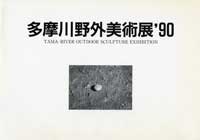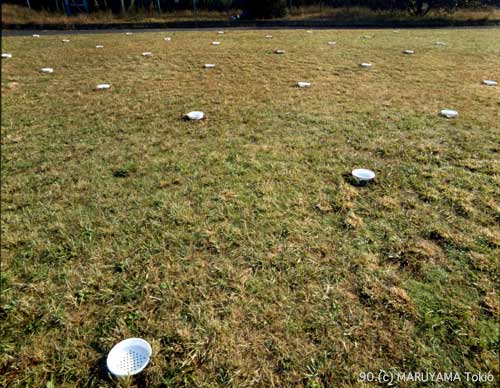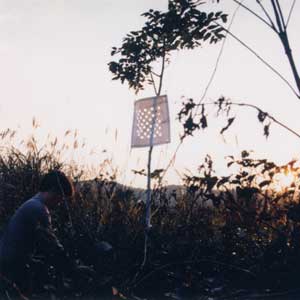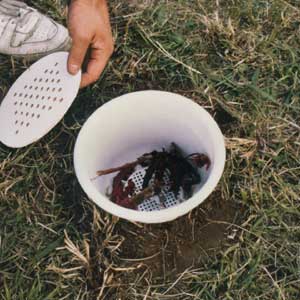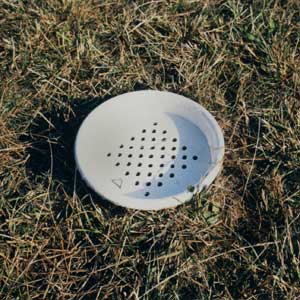MARUYAMA Tokio
1990
多摩川野外美術展1990
「土地の系」ー府中市多摩川緑地におけるフィールドワーク
それらを規則的に並べた植木鉢の中に入れ込み、穴が開けられたフタをする。この植木鉢は記憶素子を包み込む小さな環境(ミクロコスモス)といえますが、これは私達が生きている日常空間(マクロスペース)と対応しています。そして採取したそれぞれの場所には、同様の穴が開いた白いシートが設置されます。それには色々なマークが記され、植木鉢のフタの場所と対置しています。観客はちまたを歩きながら、密かに設置されたシートや、見えそうで見えない植木鉢の中を見て、自分たちの棲む環境に思いをはせることになります。
穴の形には特別な意味はありません。この形は私達が自分の身の回りの世界をもっとよく新鮮に見て、感じ、それについて思索するためのきっかけを与えるニュートラルな記号、一種の「知覚のフィルター」の役割をなすものなのです。
(多摩川野外美術展カタログより)
Walking around the site of my exhibition, I pick up many kinds of things. Some of them are natural things like leaves, soil, stones, etc., and the others are wasted things like plastics, wood, etc. They can be called a kind of メmemory chipsモ which contain the nature of the area and the time lives of the people living in the area.
I put them into regularly arranged flowerpots and cover the pots with perforated boards. The pot can be a small environment (micro cosmos), which holds memory chips in it. And it is the counterpart of the space of our everyday lives (macro space).
At each spot where an object is collected, a white vinyl sheet, which is similarly perforated, is placed. Then various marks are put on each sheet. These marks are related to the position of the cover of the flowerpot.
As they walk about the exhibit site, viewers see those inconspicuously placed vinyl sheets, and try to look inside the covered pots through the holes, and then they are to be stimulated to think about their environment.
There is no special meaning in the form of the holes. The form functions as a neutral sign (in other words, it is a kind of "filter of perception") which gives us a chance to look at the world around us more carefully with a flesh mind, and feel it and speculate about it.(From the catalogue of Tamagawa Open-Air Exhibition)
Home Copyright (c) MARUYAMA Tokio. All rights reserved.
